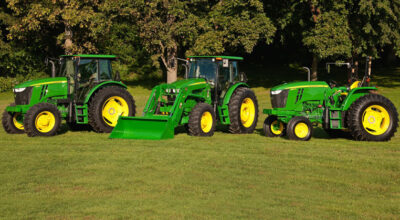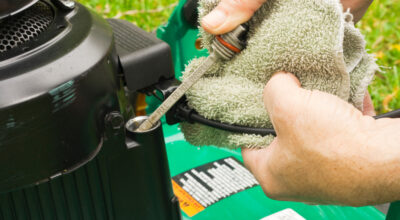In order to get the most out of your John Deere equipment, routine maintenance is essential. Tractor maintenance, in particular, can help you ensure that your machinery is operating in the best shape possible every time you gear up to tackle your to-do list. Whether you mostly use your tractor on the weekends or almost every day of the year, following the tractor maintenance guidelines in your Operator’s Manual is critical. Let’s take a look at some of the steps you can take to keep everything in working order.
15 Tractor Maintenance Tips from Spring to Winter
Here are some of the top tractor maintenance tips you should perform to be sure your tractor stays in tip-top shape for the Spring, and most importantly, throughout the year.
1. Clean the Tractor’s Exterior & Engine Cooling System
If your tractor has been stored away, it’s most likely not at its peak appearance. Start by giving your tractor a thorough cleaning, being sure to get into hard-to-reach areas that you may have avoided cleaning before storing it for the winter.
2. Read Your Operator’s Manual More Than Once
Reading your operator’s manual is a great way to ensure that you aren’t missing any tractor maintenance tips along the way.
3. Check the Engine Compartment
You never know when rodents, birds, or other varmints may set up house in your engine. Check for these little creatures before you get started.
4. Change the Fuel
If your tractor has been stored with fuel, be sure to drain excess fuel and refill the tank with a fresh supply. Stagnant fuel left in tanks can cause condensation to build up in the engine. Draining old fuel will help to ensure your engine runs smoothly.
5. Change the Oil
Similar to fuel, be sure your tractor’s oil has been drained and replaced before firing it up for the season. To be sure you don’t damage your engine, change your oil every 25 to 50 hours of usage.
6. Change the Air Filter
After a long winter stored away or a long summer season, dirt and dust will have found their way into the air filters of your tractor. If you have a closed interior tractor, be sure to change and maintain the air filters to prevent a failure of tractor components or the system.
7. Change the Spark Plugs
After 100 hours of use, it’s time to change the spark plugs. Changing the spark plugs will help prevent power outages and will help increase fuel efficiency. If you’re unsure how to change the spark plugs yourself, be sure to ask a tractor maintenance provider during your spring tune-up.
8. Sharpen the Blades
When your tractor blades are dull, you run the risk of an uneven cut on your grass. Sharpening your blades is especially important during Springtime to ensure the first cut of grass is even and looks as sharp as the blades themself.
9. Inspect Your Tires for Correct Air Pressure
Not all tractors have the same inflation pressure — meaning that the front tire pressure should not be the same pressure as the rear tire pressure. Be sure to reference your owner manual to ensure your tires are at regular intervals before operating your tractor.
10. Test Your Breaks
Testing your breaks includes checking the hand brakes and foot brakes to be sure they are working properly. If your tractor is equipped with separate left and right brakes, test them individually. A tractor with only one side of working breaks is at risk of tipping over. Remove any and all risks by ensuring each break is working properly — this way, there will be no surprises when you go out to take care of your lawn.
11. Clean Your Radiator and All Its Screens
Specifically, you’ll want to clean the screens using compressed air. The radiator is essential for the tractor’s engine to dissipate heat, meaning you do not want it clogged.
12. Tighten the Lug Nuts
Always check and tighten your tractor’s wheel bolts, also known as lug nuts. You may be surprised at how loose they can become over time.
13. Do Not Mix Grease Formulations
When lubricating your machine’s grease points, do not mix formulations. This may result in unexpected chemical reactions, and mixtures may also fail to lubricate grease points appropriately.
14. Don’t Forget About the Winterizer
Before the temperature outside falls below 32 degrees Fahrenheit, use a winterizer/antigel in your tractor’s storage tank. Failing to do so may result in your fuel literally thickening into a gel. In turn, you will not be able to operate your tractor.
15. Refer to the OM for Additional Storage Tips
Whether you’re putting away your tractor for the weekend or the season, you’ll want to refer to your operator’s manual. This will have tips for how to safely store your tractor when it’s not in active use.
To learn more about how you can properly store and maintain your John Deere Tractor, watch the video below. Or if you have any questions about how to store or maintain your Deere tractor, you can contact your local John Deere dealer.
If you enjoyed this post or want to read others, feel free to connect with us on Facebook, Pinterest, Twitter, or Instagram!


